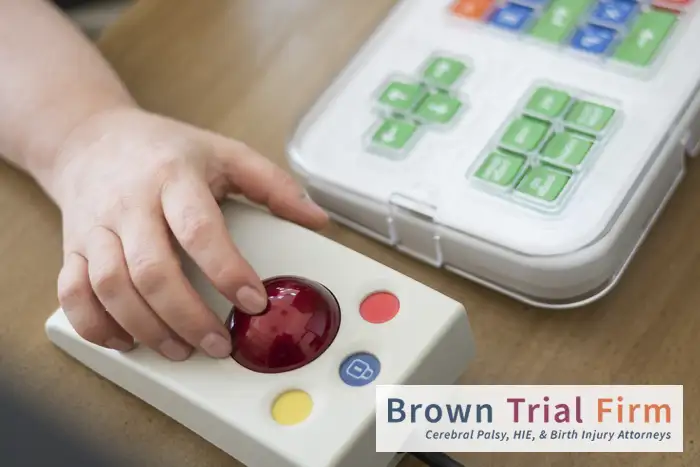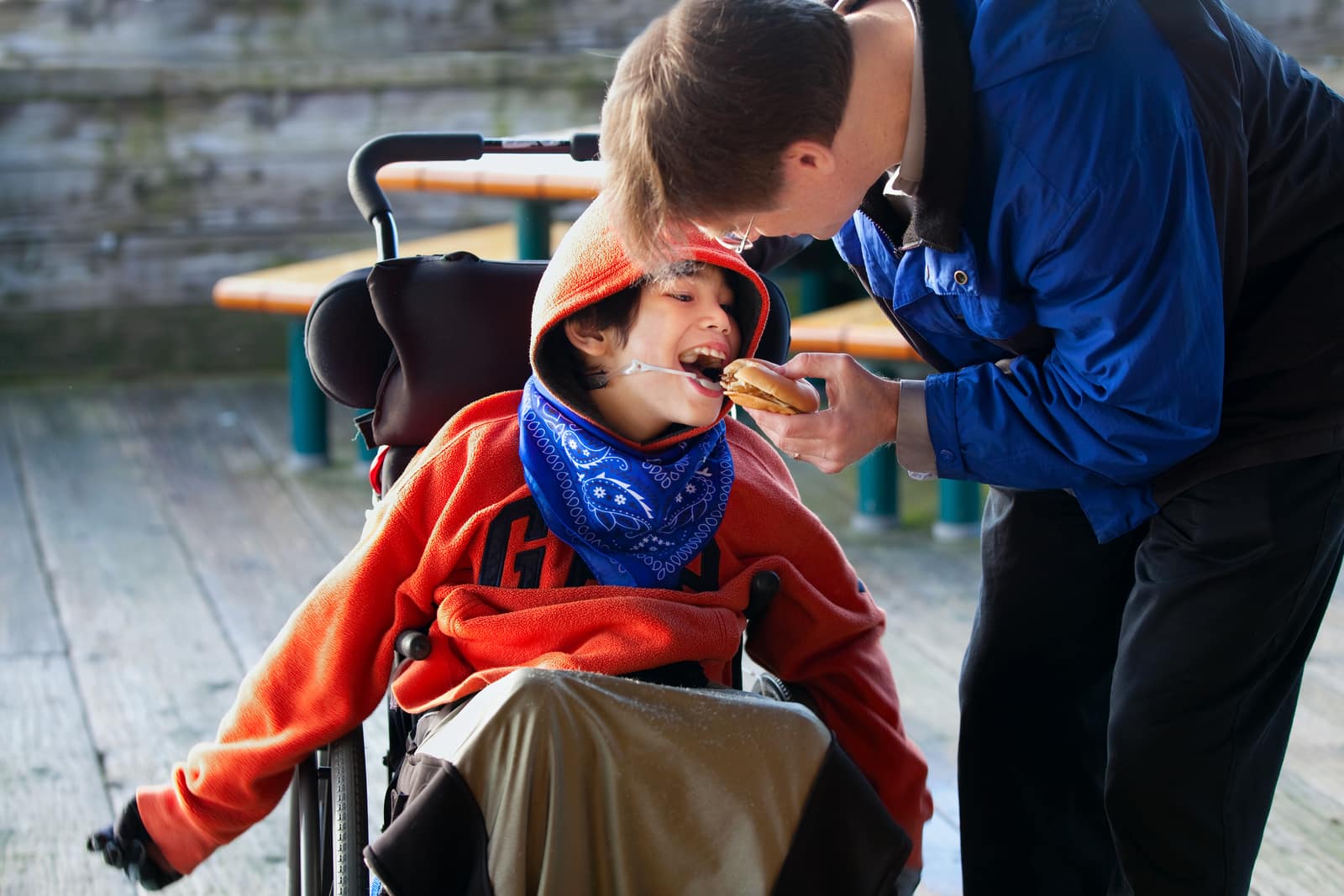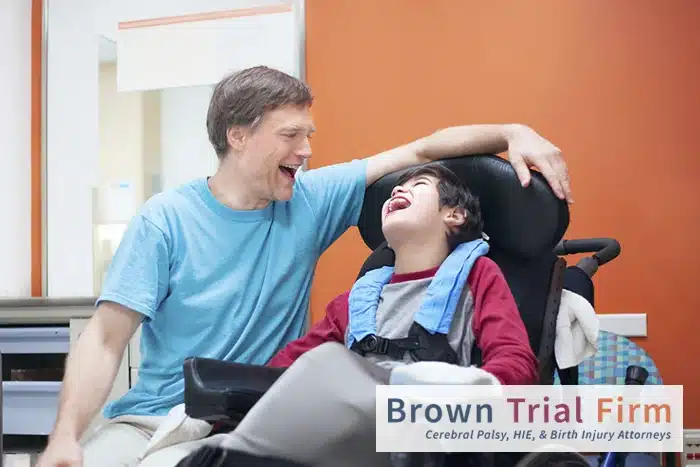Learn about symptoms, complications, and causes of dyskinetic cerebral palsy in babies and children
Dyskinetic cerebral palsy is a type of brain disorder that affects a child’s movement and muscle control. If your child has been recently diagnosed with this type of cerebral palsy (CP), you likely have a lot of questions and concerns. This page aims to be a resource for you, providing clear information about dyskinetic cerebral palsy, including its symptoms, potential complications, and known causes.
Here, we’ll break down complex medical terms into easy-to-understand language, answer common questions, and point you toward some interventions that can help your child thrive.
We understand that every child’s journey is unique, and this information is meant to be a starting point for you as you navigate this path.
What is dyskinetic cerebral palsy?
Dyskinetic cerebral palsy, also known as athetoid cerebral palsy, is a type of CP characterized by involuntary, uncontrolled, and often unpredictable movements. This form of cerebral palsy arises from damage to the basal ganglia area of the brain, which is responsible for regulating movement, posture, and muscle coordination.
Individuals with dyskinetic cerebral palsy may experience a mix of movement patterns that can include:
- Slow, writhing movements, particularly affecting the hands, feet, arms, or legs, that can be fluid or twisting.
- Sustained or repetitive muscle contractions resulting in twisting and repetitive movements or abnormal postures.
- Sudden, rapid, jerky movements that may seem to be well-coordinated but are involuntary and unpredictable.
These involuntary movements can affect any part of the body, including the face, which may impact speech and swallowing. The severity and location of the movements vary from one person to another and can change over time.
While muscle tone in individuals with dyskinetic cerebral palsy can fluctuate between too tight (hypertonia) and too loose (hypotonia), it often makes controlling movement challenging, particularly during voluntary actions.
Learn how adaptive equipment and assistive technology can improve the lives of kids with cerebral palsy and other birth injuries.
How common is dyskinetic cerebral palsy?
Dyskinetic cerebral palsy is considered the second most common form of cerebral palsy. Globally, as many as 4 out of every 1,000 children are diagnosed with some form of cerebral palsy. Of those diagnosed, approximately 12% to 14% have dyskinetic cerebral palsy.
What are the complications of dyskinetic cerebral palsy?
Dyskinetic cerebral palsy can lead to a variety of complications, affecting multiple aspects of an individual’s health and daily functioning, including:
- Motor function difficulties. Individuals with dyskinetic cerebral palsy may struggle with motor tasks due to involuntary movements. This can make activities like walking, writing, or using utensils challenging.
- Speech and communication issues. The control of facial muscles and the tongue may be affected, leading to difficulties with speech articulation, making communication challenging. This can impact social interactions and educational opportunities.
- Swallowing and feeding problems. Involuntary movements can affect the muscles involved in swallowing, leading to difficulties with feeding and the risk of aspiration, which can cause respiratory infections or choking.
- Oral health issues. Poor control over facial muscles can lead to difficulties in maintaining oral hygiene, resulting in an increased risk of dental problems, such as tooth decay and gum disease.
- Learning difficulties. Although intelligence is often unaffected, the physical and communication challenges associated with dyskinetic cerebral palsy can interfere with learning and academic performance.
- Muscle and joint problems. The varying muscle tone and involuntary movements can lead to joint stiffness, deformities, and pain. Over time, this can result in contractures (permanent tightening of muscles) and issues with posture.
- Respiratory complications. People with dyskinetic cerebral palsy may have an increased risk of respiratory issues due to difficulties with swallowing, aspiration, and reduced lung capacity from abnormal postures or scoliosis.
- Nutritional concerns. Eating and swallowing difficulties can lead to nutritional deficiencies and failure to thrive, especially in children with severe forms of the condition.
- Psychosocial challenges. Physical limitations and communication barriers can affect the individual’s self-esteem, social interactions, and overall mental health, potentially leading to anxiety, depression, or social isolation.
Managing these complications typically requires a multidisciplinary approach, including various therapies (physical, occupational, speech, and nutritional) and possibly surgical interventions. Early and ongoing intervention can help mitigate some of these complications and improve the quality of life for those with dyskinetic cerebral palsy.
Learn which foods and nutrients are most important to help children with cerebral palsy grow and thrive.
Can people with dyskinetic cerebral palsy walk?
The ability of individuals with dyskinetic cerebral palsy to walk can vary significantly from person to person, depending on the severity of their condition and the specific nature of their involuntary movements.
Some individuals with milder forms of dyskinetic cerebral palsy may be able to walk independently or with minimal assistance, while others with more severe forms may require supportive devices such as walkers, braces, or wheelchairs.
Is dyskinetic cerebral palsy genetic?
No, dyskinetic cerebral palsy is not a genetic condition (where traits or disorders are passed from parents to children through genes).
Learn about some common treatments that can help improve symptoms and quality of life in children with cerebral palsy.
Can cerebral palsy be the result of trauma during birth?
Yes, cerebral palsy can be the result of trauma during birth. While not all cases of cerebral palsy are due to birth injuries, a significant number result from complications or trauma that occur during the labor and delivery process. This kind of trauma can lead to brain damage, which in turn can cause cerebral palsy.
Types of birth trauma that can lead to cerebral palsy during birth include:
- Oxygen deprivation (asphyxia). This can occur if the baby’s oxygen supply is compromised during birth, leading to hypoxic-ischemic encephalopathy (HIE), a type of brain damage that can result in cerebral palsy.
- Physical injury. Excessive force or improper use of birth-assisting tools like forceps or vacuum extractors can cause physical injury to the infant’s head or brain, leading to bleeding, swelling, or other forms of damage that can lead to cerebral palsy.
- Premature birth. Babies born prematurely are at a higher risk for several complications, including brain bleeds, which can lead to cerebral palsy.
- Complicated labor and delivery. Situations such as prolonged labor, breech presentation, placental problems, or umbilical cord issues can lead to stressful birth conditions that may result in oxygen deprivation and injury to the baby’s brain.
It’s important to note that while birth trauma is a known cause, many cases of cerebral palsy have other origins, such as infections or maternal health conditions during pregnancy. Moreover, not all delivery complications result in cerebral palsy; the condition’s development is influenced by several factors, including the severity and location of the brain injury.
If you suspect that your child’s cerebral palsy may have resulted from a medical mistake before, during, or after childbirth, it’s crucial to seek legal advice to discuss your options for pursuing financial compensation.
Looking for answers about your child’s cerebral palsy diagnosis? Get help from an experienced birth injury attorney.
If your child has received a diagnosis of dyskinetic cerebral palsy, understanding your legal rights and options is crucial, especially if medical negligence could have contributed to their condition.
At Brown Trial Firm, skilled birth injury attorney Laura Brown offers specialized support for families navigating the aftermath of birth injuries. With an emphasis on compassionate service and legal expertise, Laura and her team are dedicated to advocating for the rights of your child, aiming to secure the justice and compensation needed for their ongoing care and well-being.
Reach out to the Brown Trial Firm today to schedule a free consultation to learn how we can assist in safeguarding your child’s future.
- Cerebral Palsy
- Caput Succedaneum and Cephalohematoma
- Neonatal Intracranial Hemorrhage (Childbirth Brain Bleeds)
- Hydrocephalus (Extra Fluid in the Brain Cavity)
- Cervical Dystonia
- Hemiplegia (Brain or Spinal Cord Injury)
- Hemorrhagic Stroke
- Neonatal Stroke
- HIE
- Periventricular Leukomalacia (PVL) Brain Injury
- Infant Seizures
- Spastic Diplegia (Spasticity in the Legs)
- Top Risks for Birth Injuries
- Fetal Alcohol Syndrome
- Facial Paralysis
- Spinal Cord Injuries
- Bell’s Palsy
- Brachial Plexus Nerves & Erb’s Palsy
- Klumpke’s Palsy
- G-Tubes for Newborns
- Medical Errors
- Cesarean Section & Birth Injury
- Negligence in Brain Cooling Treatment
- Craniosacral Therapy
- Occupational Therapy
- Speech Therapy
- Transition From Pediatric to Adult Healthcare
- Surgical Options for Spastic Cerebral Palsy
- Fetal Intolerance to Labor
- Jaundice (Kernicterus)
- Breech Position
- Placental Complications
- Umbilical Cord Problems
- Uterine Rupture
- Cervical Incompetence (Insufficiency)
- Blighted Ovum
- Necrotizing Enterocolitis (NEC) - Intestinal Inflammation
- Cephalopelvic Disproportion
- Meconium Aspiration Syndrome
- Amniotic Fluid Embolism
- Birth Injury from Premature Delivery
- Developmental Delays
- Abnormal Cord Insertion
- Infections at Birth
- Chorioamnionitis Bacterial Infection
- Premature birth
- Oxygen Deprivation
- Listeria
- Birth-Acquired Herpes
- Placenta Previa
- Placental Abruption
- Mismanaged Fetal Malposition
- Rapid Labor
- Obesity Related Birth Injuries
- Intrauterine Growth Restriction
- Blood Clots During Pregnancy
- Ectopic Pregnancy Misdiagnosis
- Myths & Facts About Birth Injuries
- Bacterial Vaginosis
- Gestational Diabetes
- Maternal Mortality Risk
- Oligohydramnios (Low Amniotic Fluid)
- Infections During Pregnancy
- Excessive Bleeding During Pregnancy
- Congenital Syphilis





